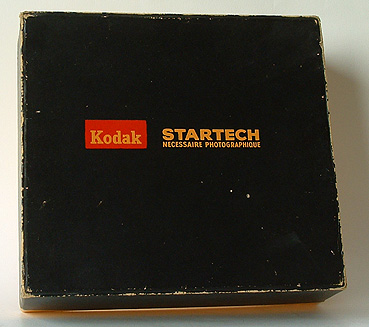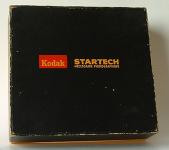|
Kodak Startech |
Manufactured or assembled in France from 1963 to (After) 1963.
Index of rarity in France: Rare (among non-specialized garage sales)
Inventory number: 615
See the complete technical specifications
Chronology of cameras Kodak
At the end of the Second World War, Kodak had two historic factories in France: one in Sevran, which had been dedicated to film development since the 1920s, and another in Vincennes, formerly known as Pathé and since 1927, Kodak-Pathé, where films were manufactured. There were no camera manufacturing units at that time, and all Kodak cameras available in France were imported products.
As part of the national industrial reconstruction effort, imports became much more difficult, and it became necessary to manufacture the cameras sold in France domestically. This is what Kodak did, based on four series of cameras: the 127 series with names starting with "Star," the Pony series, an entry-level 135 series, the Retinette series, a higher-quality 135 series, and folding cameras in the 620 format. For each of these series, Kodak used existing camera models from the USA or Great Britain as a basis. The question arises as to whether this involved true manufacturing or simply assembly with French-made lenses. The Brownie Flash can also be mentioned in this context.
The French Kodak cameras with names starting with "Star" all have a 4 x 4 cm format on 127 film. They are made of plastic, fixed-focus, with a simple eye-level viewfinder integrated into the camera. They have two apertures and a single shutter speed. Loading is done by opening the bottom, which allows access to the two spools and the chamber.
The front face is adorned with an aluminum plate, almost identical from one model to another. The Kodak logo sometimes changes sides, and the Brownie logo evolves. The shutter release lever is very small and red in color. It's possible that some plastic components are common to several models; for example, the Starflash has a parabolic reflector for a bulb flash, but the two holes for flash attachment on the Starlet are clearly visible.
These models are derived from their American counterparts, but across the Atlantic, some "Star" models never had French equivalents.
| Model | Flash | Years | ||
| Starflash |  |
PF1 bulb flash parabolic reflector. The 22.5V battery for the flash is located behind the reflector. | Kodak logo on the left or right. |
1960-62 |
| Startech |  |
Derived from the Starflash, designed for macrophotography. The aperture settings are replaced by those for the focusing distance. | Sold with the essentials for close-up photography. |
c. 1963 |
| Starlet |  |
Side connection for a bulb flash. | Kodak logo on the left or right. Aperture indicated by "Color/ Black & White" or "Hazy Sun / Bright Sun." The plate on the top can be smooth or textured. |
1960-66 |
| Starluxe |  |
Small round reflector for PF1 bulb. In the compartment for the 22.5-volt battery, there is an adapter for AG1 bulb. | 1961-65 | |
| Starluxe II |  |
Small rectangular reflector for a bulb. The technical specifications remain unchanged. | Available in white or two-tone. | 1964-67 |
Traduction de Sylvain Halgand
In what, Startech does differ it from usual Starflash and why?
Startech aimed at the customers of the dentists, which it made it possible to take large plans of the mouth ( Ahhhhh!), but also any person wishing to make macrophotography.
For that, it was sold with a set of two caps (green and a red) to put in front of the lens, in order to modify the distance minimum of clearness. The cap was to correspond to the setting of the aperture (calibrated in-depth of field): 25-40 cm for the green one and 10-20 cm for the red (10-16 inches or 4-6 inches on the American version). To facilitate the calculation of the distance, a chain * with three colors (metal, red, green) was attached to the camera and was to be tended by the photographer, between the camera and the subject. The color of the chain in contact with the object determined the cap to install. A metal framework to fix under the camera made it possible to maintain the distance minimum between the lens and the object and facilitated framing.
In front of the former window of the finder seat a small prism took which made it possible to the dentist to see the teeth and not the holes of nose of the patient. Interdependent of the prism, a transparent protection covered the aperture of the parabola of the flash. I do not know if it protected the patient from the flash or the reverse… The two visible rivets of each side of the finder made it possible to maintain the prism-protection unit.
In the outfit was a gray “decoration”, way melts of studio, as well as a black paper sheet.
Startech exists only in white.
* This chain does not exist in the American kit. The instructions advise to use a cord with nodes at the adequate distances! The metal framework misses also American kit.


Interesting links or bibliography :
 |
Add a link or element of bibliography, a picture taken with this camera, a picture of box or an ads about this camera
Your photos taken with the same camera:
Cameras from Ebay France (Kodak) (Uploaded each 3 hours)








